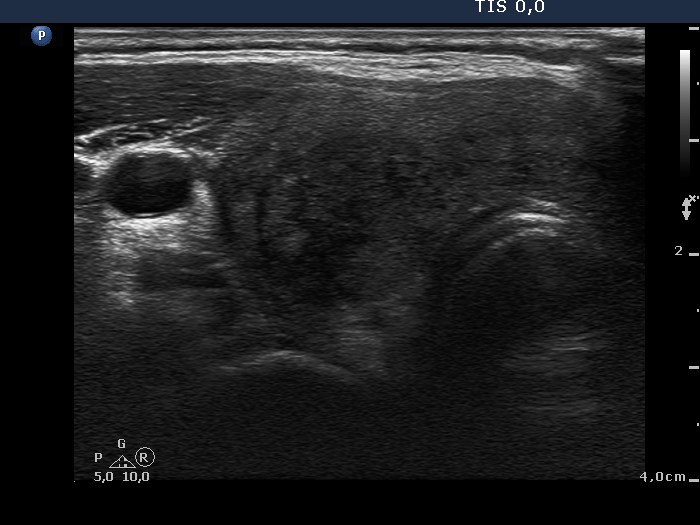Subacute granulomatous de Quervain's thyroiditis - Case 12. |
|
First examination (1st to 3rd rows of images):
Clinical presentation: a 37-year-old woman requested a second opinion. She was treated for de Quervain's thyroiditis causing pain originally in the left lobe for 3 months. After getting off steroid therapy, her complaints recurred in the right thyroid. An ultrasound was performed and a nodule was detected which was described as suspicious on the report. S urgery was advised. The patient presented pain in the right side of the neck, subfebrility and fatigue.
Palpation: both thyroids were very firm. The right thyroid was tender.
Laboratory tests: euthyroidism with TSH 0.26 mIU/L, FT4 18.2 p M/L. Erythrocyte sedimentation rate 137 mm/H, CRP 11.5 mg/L.
Ultrasonography: the right thyroid was echonormal and contained multiple hypoechogenic lesions with blurred borders in the dorsal part. The left thyroid contained similar areas. The vascularization was almost absent in the right but decreased in the left lobe.
Cytology was performed from the right hypoechogenic area evaluated as a nodule on a previous radiological examination and resulted in benign, subacute, granulomatous, de Quervain's thyroiditis.
Steroid was started with daily 32 mg methyl-prednisone and gradually decreased every 5 days with 8 mg. The complaints of the patient stopped the day after the first dose of steroid. Her complaints recurred again after the discontinuation of steroid.
Second examination 14 months after the initial (4th row of images):
Clinical examination: the complaints did not come back after the third course of steroid.
Palpation: no abnormality.
Laboratory tests: euthyroidism with TSH 3.49 mIU/L, FT4 13.1 pM/L. CRP below 0.5 mg/L.
Ultrasonography: the right thyroid became near echonormal and decreased in size. The hypoechogenic blurred areas have disappeared. The vascularization has normalized.
Comments:
Informing a patient is essential: de Quervain's thyroiditis may last for six months, exceptionally even for a year. We administer the steroid to resolve the inflammatory complaints of the patient, but this therapy has no effect on the duration of the complete recovery. In our practice more than half of the patients require 2 and more than 10% of patients require 3 courses of steroid.
The sonographic pattern of de Quervain's thyroiditis is very close to that of papillary cancer: hypoechogenicity and blurred borders are common in both diseases.
.
















